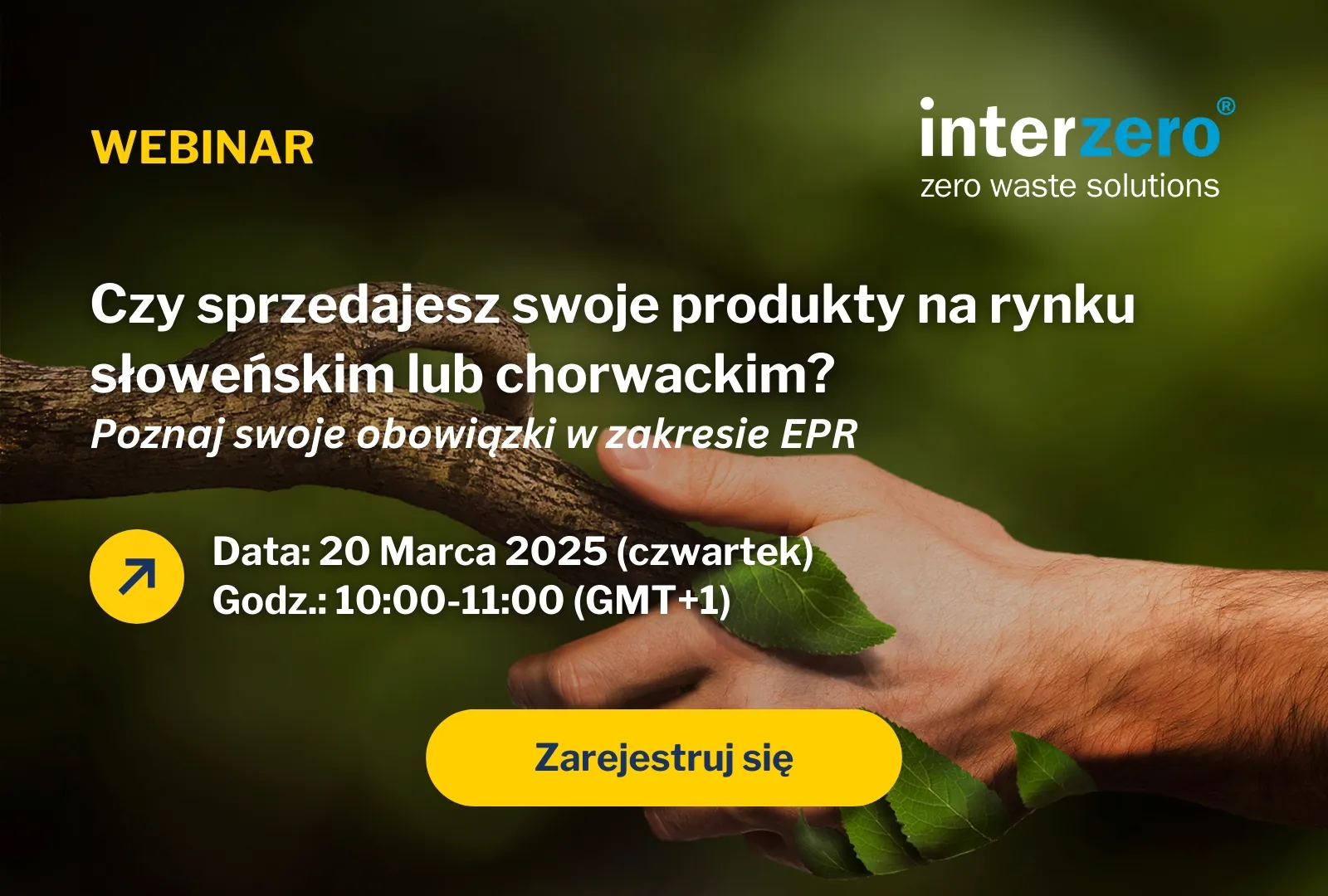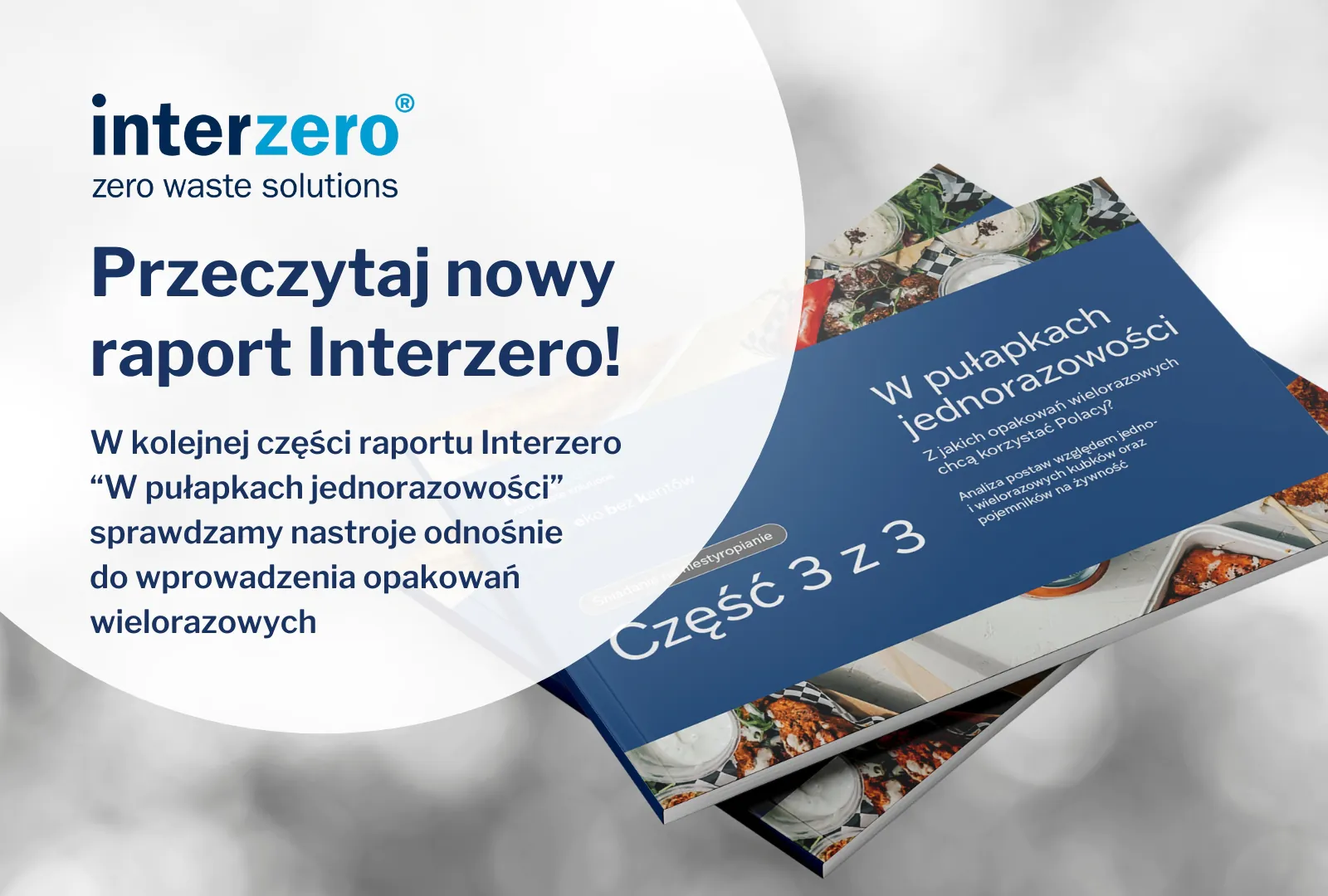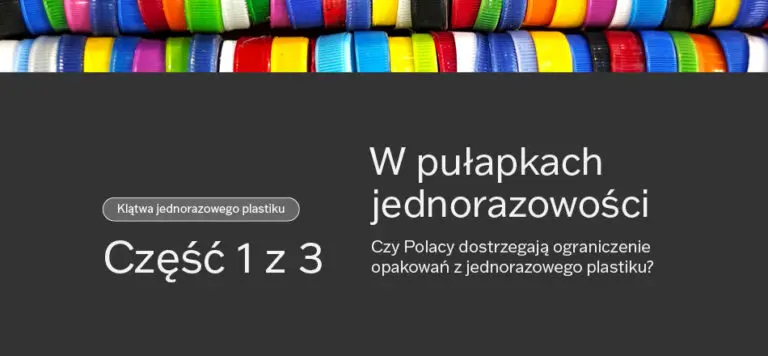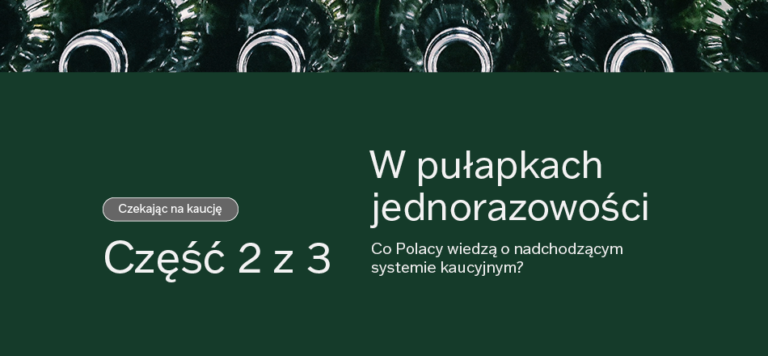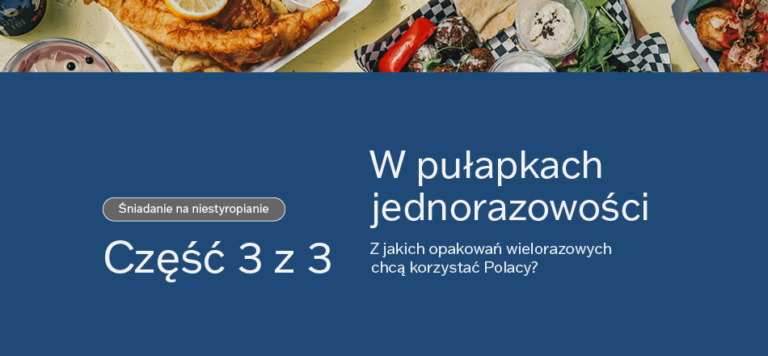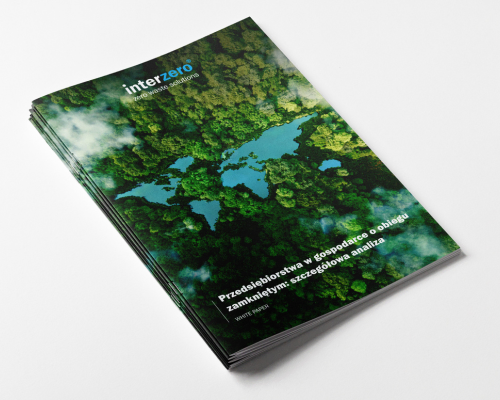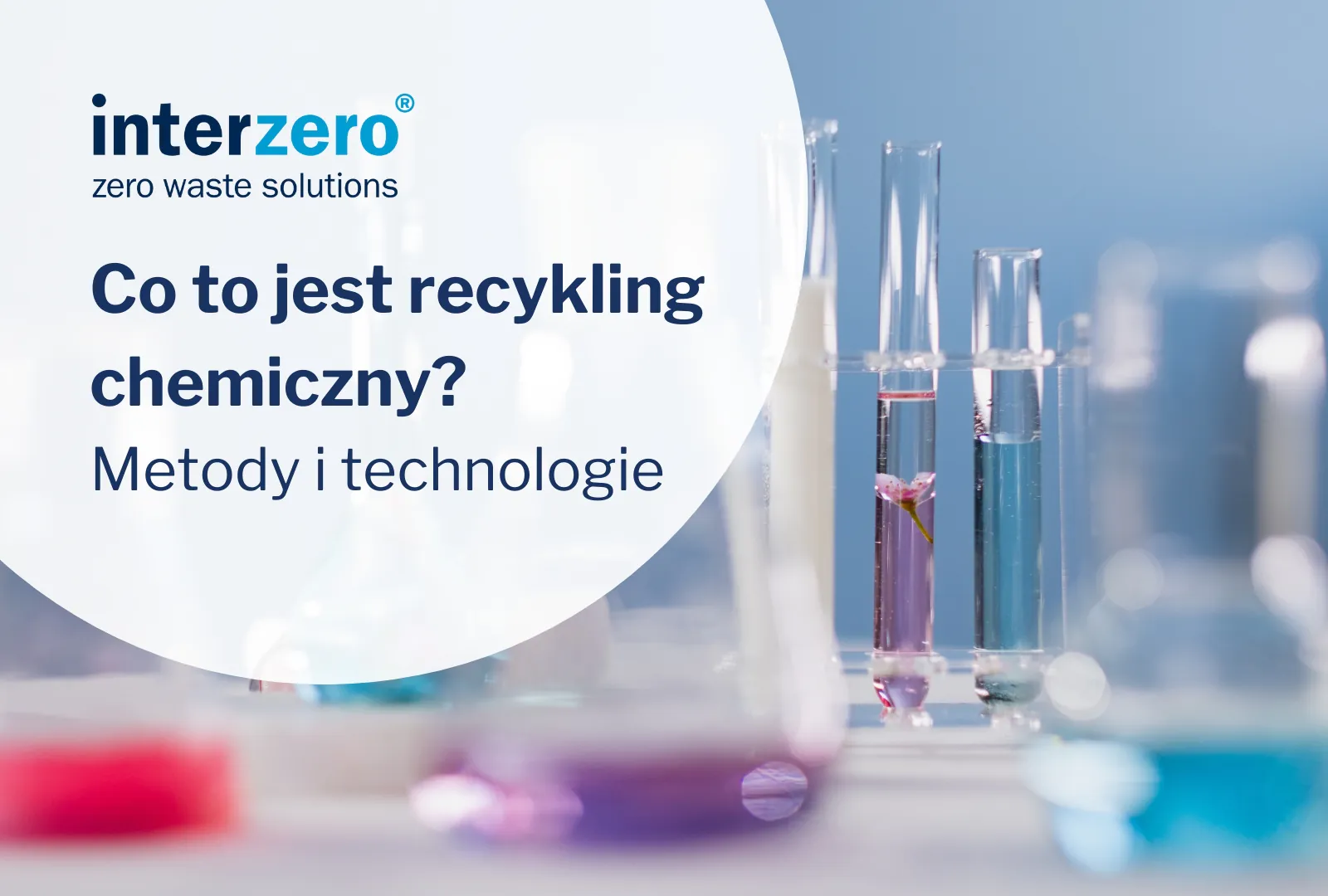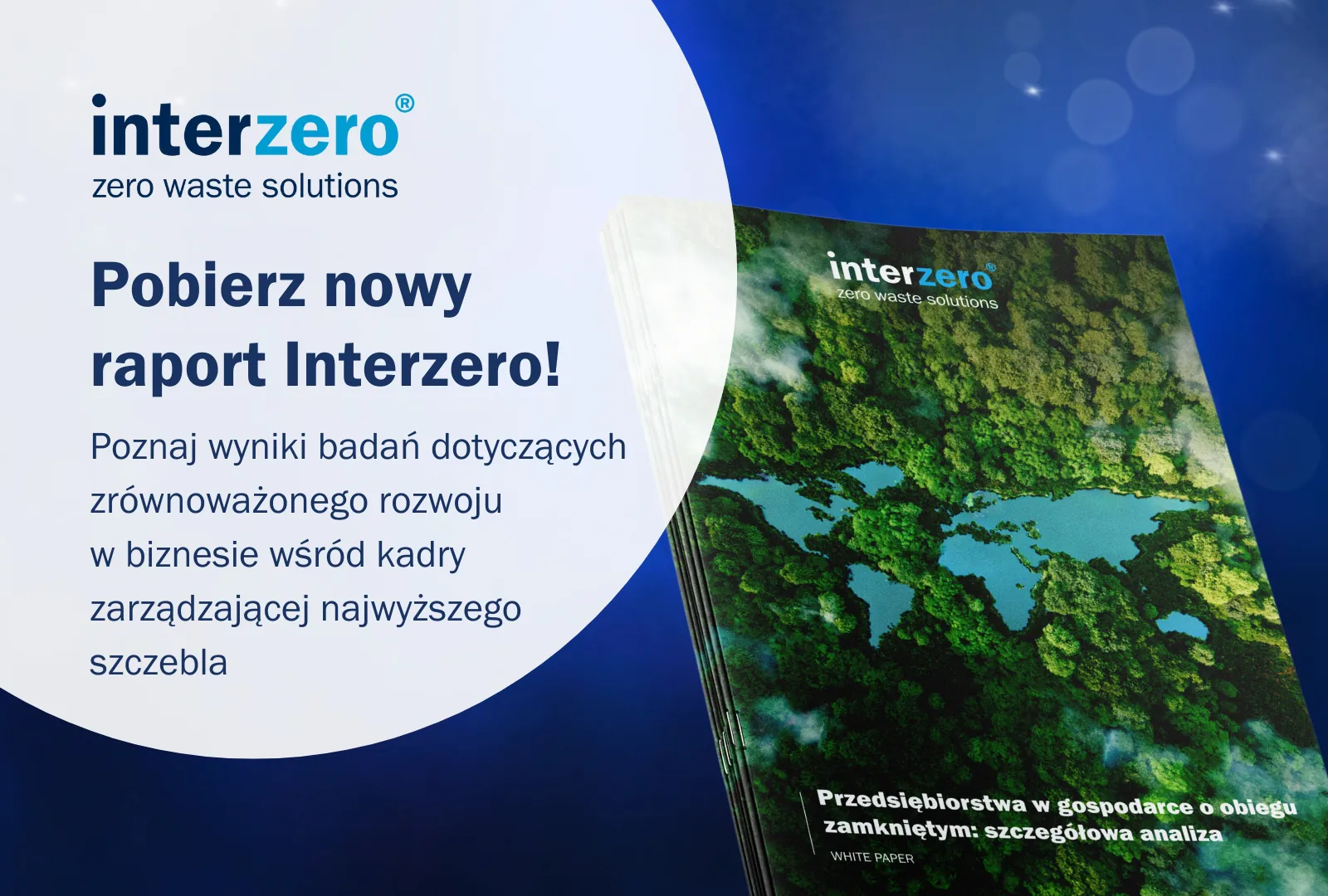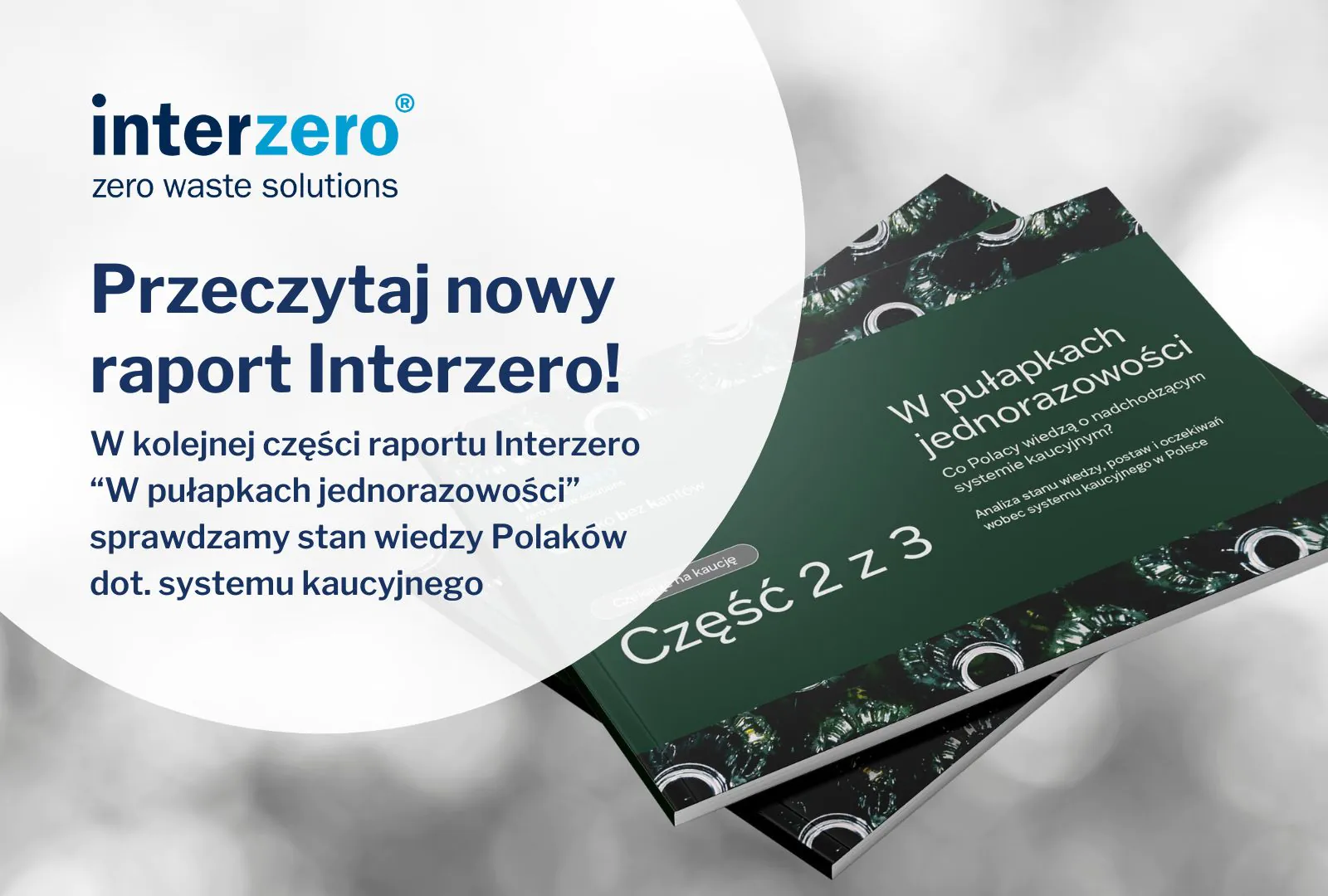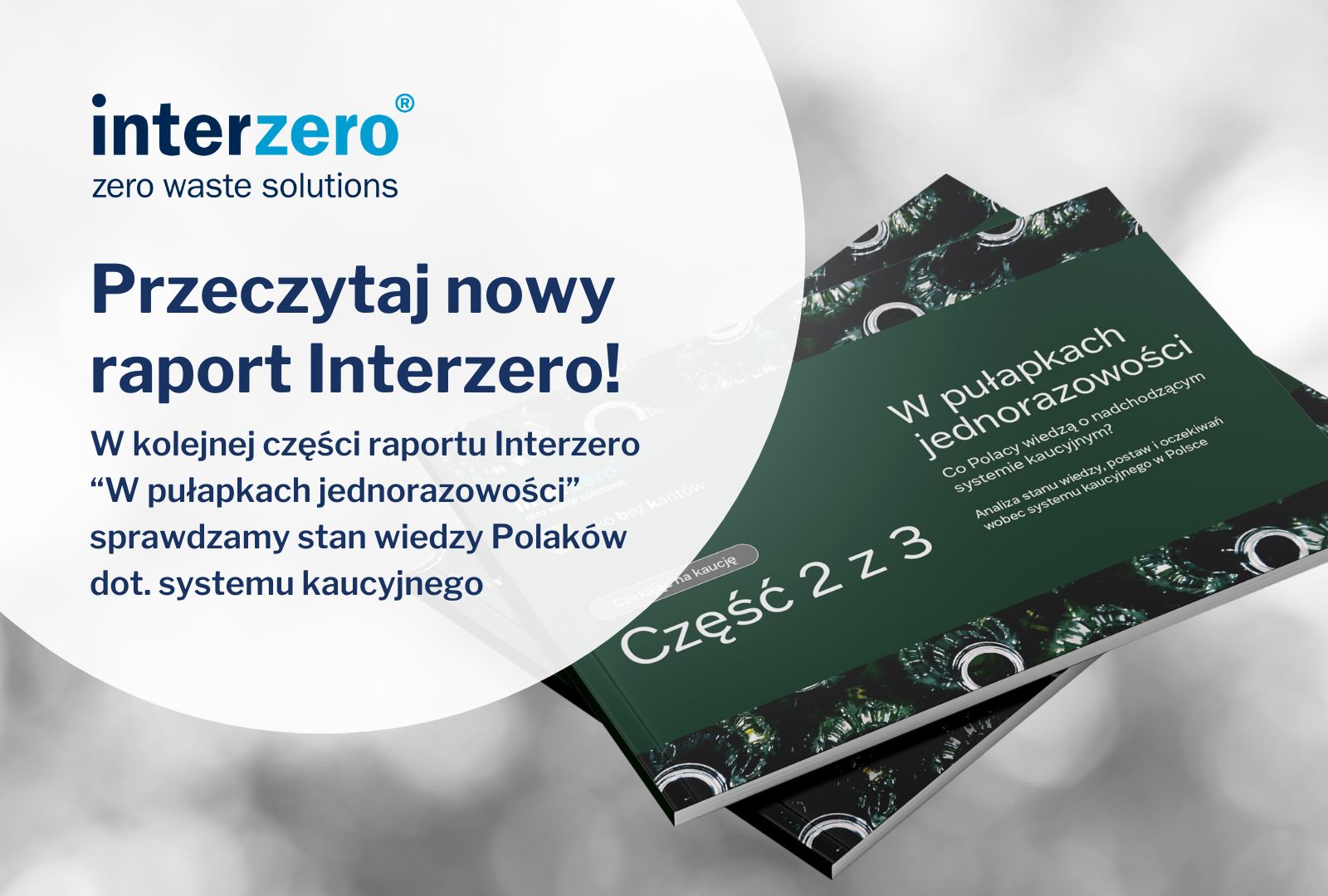What's new at Interzero? Check out the February summary
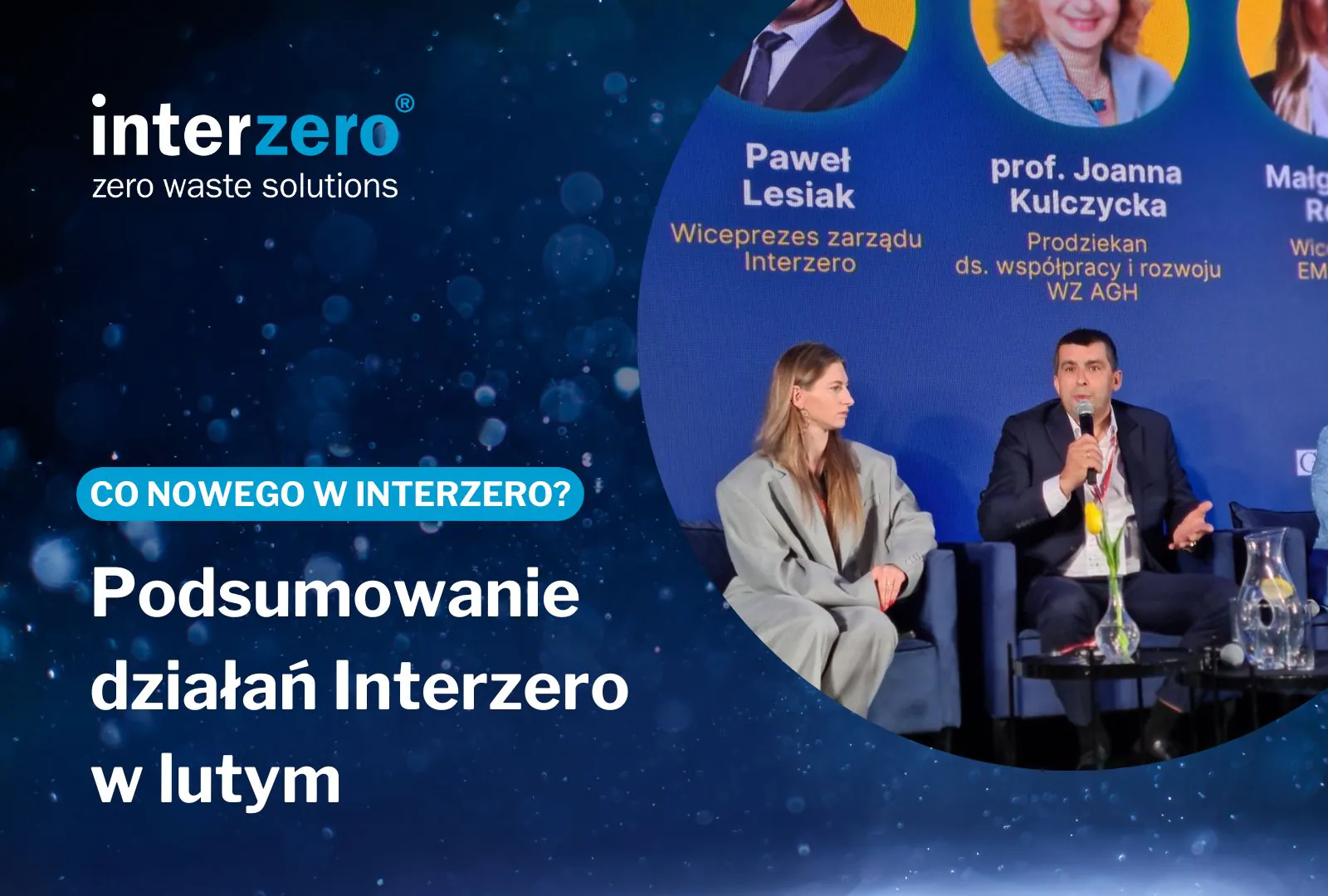
How was February at Interzero? Read the monthly summary
The past month was full of important events and initiatives at Interzero. As part of the educational campaign Eco without the angles, we published the third part of the report "In the traps of single-use", which analysed the approach of Poles to reusable packaging. We also actively participated in the Sustainable Industry Lab 2025, where the presentation of the Waste Platform 2.0, which makes it easier for entrepreneurs to fulfil their environmental obligations, aroused particular interest. Check out what's new at Interzero below!
EkoPaka - we are not slowing down
In February, the pilot edition of our flagship educational programme EkoPaka ended. 100 classes from Warsaw and the surrounding area received boxes filled with materials supporting teachers in conducting interesting and engaging classes on paper. Students learned how paper is produced, how often it accompanies us in everyday life, how important its proper segregation is and whether it is possible to recycle it. At the same time, they practiced their manual skills and creativity. During classes, they built a cardboard forest, conducted an investigation in their school on the use of paper, created posters, collages and many other beautiful works. Also this month, we finished recruitment for the second edition of EkoPaka on bio-waste. This time, as many as 200 packages will be sent to schools. We encourage you to follow our website and social media profiles.
Reusable vs. disposable - how do Poles perceive takeaway packaging?
The past month has brought important conclusions regarding the future of reusable packaging. Our new report examines how Poles perceive alternatives to single-use plastic, which, according to the SUP directive, must have a reusable option since July last year. This is the third installment of the series "In the traps of single-use plastics", in which Interzero analyses the consequences of the SUP (Single-Use Plastics) directive for everyday consumer decisions. This time, the experts focused on takeaway habits and checked what features the ideal reusable packaging should have according to Poles. The full report is available for download on the Eko Bez Kantów website .
Interzero at Sustainable Industry Lab 2025
Our experts shared their knowledge on technological solutions supporting sustainable development and how to effectively manage waste. The speakers included: Paweł Lesiak, Vice President of the Management Board, Łukasz Czarnowski, Digital Sales Cross Country Function Head and Robert Kowal, Business Development Manager. The discussions concerned, among others: digital challenges in waste management, the role of IT tools in ESG reporting, the importance of reliable data in ESG strategy - how their analysis helps to reduce emissions and build transparency of companies' activities, growing consumer awareness - why education and an innovative approach to sustainable development are so important for the future of business. You can read more about the speeches on our fanpage.
Selling to Spain? Remember your EPR obligations!
If you export your products to the Spanish market, you must comply with the requirements of Extended Producer Responsibility (EPR). Spanish regulations cover both local companies and foreign companies that introduce to the market: packaged products (domestic, commercial, industrial), electrical and electronic equipment (EEE), batteries, accumulators and devices containing them. Companies outside Spain must appoint an authorized representative to handle the formalities on their behalf . With Interzero it's easy! Simply sign the agreement and we will take over your EPR obligations. We will provide full support in registration, reporting and ongoing implementation of environmental obligations, regardless of the scale of operations.
Interzero 2025 Environmental Conference - save the date!
The 2025 Environmental Conference is getting closer! On June 3-4, we will meet at the Warszawianka Hotel near Serock to discuss the most important legal changes in the field of environmental protection. This is an event that you cannot miss if you want to stay up to date with regulations regarding SUP, ROP, PPWR and ESG. In March, there is a -15% discount on the regular price, so it's the perfect time to register! The event agenda is almost ready. See you in June!
Are you selling your products on the Slovenian or Croatian market? Join our free webinar in English
Are you selling your products on the Slovenian or Croatian market? Join our free webinar in English
If you are a company based outside Slovenia or Croatia but sell your products to end consumers in these markets, you are subject to a number of environmental obligations. To gain valuable information and avoid potential penalties, we invite you to join our free webinar on Thursday, March 20.
Know your EPR responsibilities
Webinar Do you sell your products on the Slovenian or Croatian market? Get to know your EPR obligations
in English will take place on Thursday, March 20 from 10:00.
Our speakers, both environmental consultants, Katariina Jerbić from Croatia and Matej Marka from Slovenia , will present environmental obligations, focusing mainly on extended producer responsibility (EPR) in Slovenia and Croatia.
Join our session and learn about the following topics:
- Environmental Obligations in Slovenian and Croatian Law - Introduction
- Extended Producer Responsibility (EPR) explained
- Mandatory waste streams in Slovenia and Croatia
- Licensing requirements for e-commerce sellers and manufacturers
- Who is required to have an authorized representative in Croatia and Slovenia
- Reporting
- Best practices and support for companies
- Q&A session
The complexity and volume of environmental responsibilities can be stressful if you don't have a reliable partner by your side. That's why we encourage you to take advantage of this free opportunity to expand your knowledge with our specialists.
Are Poles ready for a world without disposables?
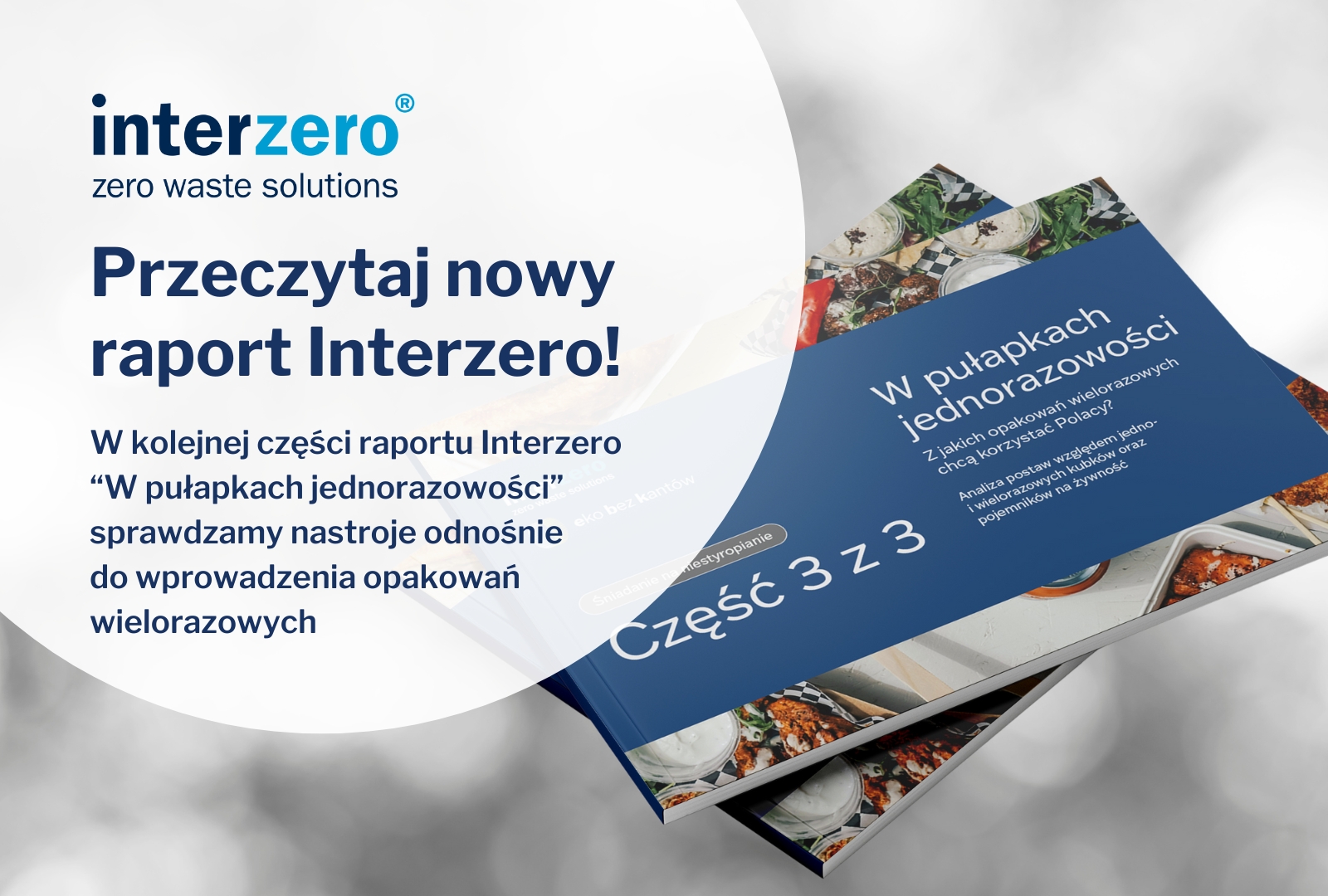
Are Poles ready for a world without disposables?
Leak-proof, lightweight and... a discount for using them? This is how Poles imagine the ideal reusable packaging - according to the latest Interzero report "Breakfast on non-styrofoam" . This is the third and final part of the series "In the traps of disposables" , which focuses on consumer attitudes towards reusable packaging.
We wrote more about the report carried out as part of the Eco without Kants campaign in the article SUP Directive, or a half-hearted revolution and "Waiting for a deposit" - what Poles know about the deposit system ... and what they don't know
In an era of growing environmental awareness, more and more companies and consumers are looking for ways to reduce single-use plastic. However, the reality is more complicated than it might seem. Interzero 's publication "In the Traps of Disposability" (Part 3) sheds light on the key challenges associated with the transition to more sustainable packaging. In this report, we examine why, despite good intentions and increasing regulations, it is still difficult to completely eliminate single-use products, and what solutions can help combat excessive waste production.
Ecology versus convenience - what do consumers choose?
Studies show that while environmental awareness is growing, for many of us convenience still trumps environmental concerns. One of the challenges highlighted by respondents is the issue of packaging for popular takeaways such as pizza, burgers and fries. For many, the idea of using reusable containers for fast food seems impractical - "I order pizza to avoid cooking and washing up, not to clean the container afterwards," says one of the respondents.
What does your favourite packaging look like?
Over 58% of Poles expect reusable packaging to be, above all, tight, easy to clean, and lightweight. Interestingly, for many, the key factor is also the possibility of obtaining a discount or reward for using it.
The report also shows that Poles are reluctant to use shared models - most prefer to have their own containers rather than borrow them from restaurants on a deposit basis. They are afraid of the mess, the need to store different packaging and the additional obligations associated with returning them.
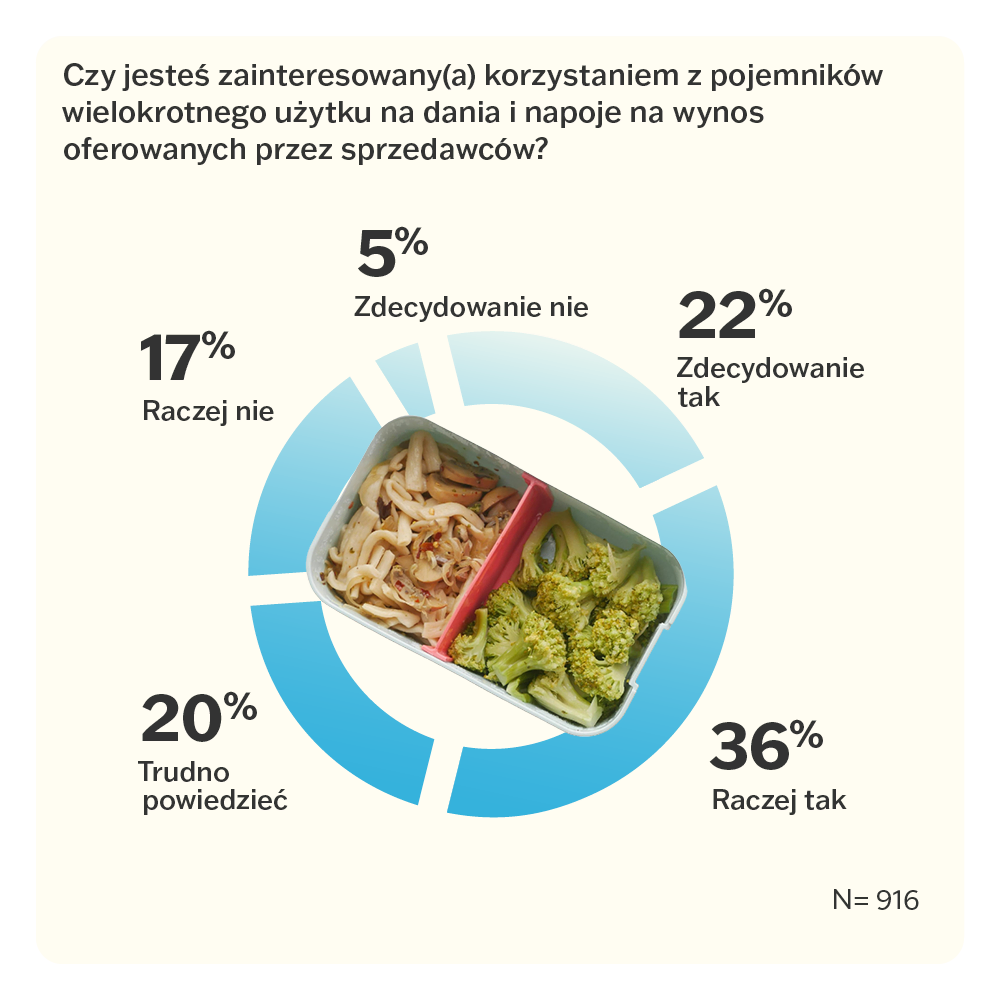
Why is it worth reading the report?
The report "Breakfast on Non-Styrofoam". is not just about numbers - it is primarily the voices of consumers , their opinions and real concerns. The collected data can be a valuable source of knowledge for entrepreneurs from the HoReCa, e-commerce or packaging manufacturers who want to better adapt their products to market expectations.
Read all sections of the report!
Support with EPR obligations in Spain: packaging registration and authorized representative
Businesses introducing packaged products, electrical equipment and batteries to the Spanish market must comply with many obligations imposed by the regulations on extended producer responsibility (EPR). This also applies to foreign companies, which the legislator has additionally obliged to establish an authorized representative in Spain. How to comply with the new EPR regulations in Spain?
EPR obligations in Spain that all foreign companies are subject to
The regulations on Extended Producer Responsibility (EPR) in Spain were introduced by several legal acts: Law 7/2022 of 8 April 2022 and Royal Decrees 106/2008, 110/2015 and 1055/2022. According to these regulations , all traders who sell packaged products, electrical and electronic equipment and batteries and accumulators to Spain must comply with a number of legal obligations .
The most important responsibilities of the EPR in Spain include:
- obtaining a tax identification number (NIF),
- registration in the Producer Register - Registro de Productores de Producto (Spanish equivalent of BDO) and obtaining an individual EPR number,
- ensuring the management of waste generated from packaging, equipment (WEEE) and batteries introduced to the Spanish market,
- submitting annual reports on the types and quantities of products covered by the EPR that the entrepreneur has introduced to the Spanish market,
- licensing of introduced packaging and equipment
Foreign entrepreneurs cannot perform any of these tasks on their own - EPR regulations oblige them to appoint an authorised company representative in Spain who will take over all the obligations related to extended producer responsibility.
Who is obliged to appoint an authorised representative in Spain?
The obligation to appoint an authorised EPR representative applies to companies not established in Spain that introduce to the Spanish market:
- electrical and electronic equipment (e.g. household appliances, consumer electronics, electronic toys),
- batteries and accumulators (as well as devices containing batteries or accumulators),
- products in packages :
- domestic ( individual in which the product is delivered to consumers),
- commercial (used for storage and packaging in retail and service outlets),
- industrial (collective) .
EPR regulations apply not only to entrepreneurs selling the above-mentioned products through traditional distribution channels (stationary shops, wholesalers). They also cover companies that offer their products through own online stores or sales platforms, e.g. Amazon, Zalando or eBay.
Importantly, Spanish EPR regulations do not provide for quantitative exemptions, which means that even companies that sell just a few such packages or products to Spain must appoint an authorised representative. Signing an agreement with an entity that will take over EPR obligations in Spain is therefore a necessary condition that all entrepreneurs introducing any packaged products, batteries and accumulators, and electrical and electronic equipment to the Spanish market must meet.
Do you already have an authorized representative in Spain? Discover the Interzero offer!
At Interzero, we provide comprehensive support to entrepreneurs in fulfilling their obligations under Extended Producer Responsibility (EPR). We offer an authorised representative service in Spain to all companies that introduce packaged products, electrical and electronic equipment, and batteries to the Spanish market.
As an authorized representative of your company in Spain , we will take care of:
- registration of your company in the Spanish Register of Producers,
- recycling and management of waste from packaging, equipment and batteries that you introduce to the Spanish market,
- joining the extended producer responsibility system (EPRS, SCRAP),
- reporting on packaging, equipment and batteries introduced in each calendar year,
- licensing of packaging and equipment and payment of licensing fees on behalf of your company (if necessary),
- representing your company in the scope of EPR obligations before Spanish authorities and offices.
Discover the range of our services and choose Interzero as your authorized representative in Spain!
How do I appoint Interzero as an authorised representative of my company in Spain?
By choosing Interzero services, you will complete all formalities quickly, conveniently and 100% online .
- Create a free account for your company on Interzero España (it only takes 1 minute!).
- Complete the information on the quantity and types of packaging being introduced and calculate the cost of the service.
- Confirm your details and proceed to finalise your order.
- Follow the further instructions that we will send you electronically.
Once the formalities are completed, we will take care of registering your company and fulfilling the remaining obligations arising from the EPR in Spain.
FAQ
Find answers to the most frequently asked questions about the Authorised Representative and EPR regulations in Spain.
For more information click here: EPR Obligations - Interzero Authorized representative in Spain
Who is the Manufacturer's authorized representative in Spain?
The Authorized Representative in Spain is the company's representative who takes responsibility for fulfilling the Producer's obligations under the Spanish EPR regulations. If your company is not based in Spain, you can only fulfill your obligations under the EPR through an Authorized Representative!
Who is a Producer under the Spanish Extended Producer Responsibility (EPR) regulations?
According to the Spanish EPR regulations, the term Producer should be understood as meaning any entrepreneur who manufactures, sells, packages, imports or carries out intra-Community supply of packaged products, electrical and electronic equipment or batteries and accumulators on the Spanish market.
This applies to both entrepreneurs based in Spain and foreign companies (based in the EU or outside the EU).
Under Spanish regulations on extended producer responsibility, packaging producers are also:
- sellers, courier companies and online sellers who use shipping packaging to deliver the products they sell,
- companies not based in Spain that use packaging to introduce products to the Spanish market,
- e-commerce platforms that introduce products packaged outside Spain to the Spanish market,
- companies that package products directly at the point of sale (e.g. takeaway food),
- entities involved in packaging products intended for introduction to the Spanish market.
How do I know if I need an authorised representative in Spain?
If you are introducing packaged products, electrical and electronic equipment or batteries and accumulators to the Spanish market and you are not based in Spain, you probably need to appoint an authorised representative of your company in Spain. The definition of Producer provided above may be helpful in identifying your obligation.
NOTE: Spanish EPR regulations do not provide for quantitative exemptions. EPR obligations must therefore be fulfilled by all Producers, regardless of the quantity of packaged products, equipment and batteries placed on the market.
Need more information about EPR obligations in Spain and other European countries?Create a free account at Licenzero and learn about your company's obligations!
Since when has the appointment of an authorised representative in Spain been mandatory?
The obligation to appoint an authorised representative in Spain came into force on 1 January 2023. From now on, all foreign entrepreneurs who introduce packaged products, electrical and electronic equipment or batteries and accumulators to the Spanish market must fulfil their obligations as an introducer through an authorised representative.
Who can be an authorised EPR representative in Spain?
The authorized representative of your company in Spain can be a natural person, a legal person or an organization that meets all of the following conditions :
- has an address (registered office) in Spain,
- is a member of one of the extended producer responsibility systems in Spain (SCRAP),
- is registered in the Spanish Register of Producers ( Registro de Productores de Producto ).
Remember that your company's authorized representative will perform your duties and represent you before Spanish authorities and offices! For this reason , choose only experienced, proven entities as your authorized representative, who can guarantee the highest quality of services provided!
When do I need to appoint an authorised representative in Spain?
You should appoint an authorised representative for your company before you start your business of introducing packaged products, electrical equipment or batteries and accumulators to the Spanish market. If you currently sell such products to customers in Spain and you are a manufacturer within the meaning of the Spanish EPR regulations, you must appoint an authorised representative as soon as possible.
What tasks does an authorised representative in Spain perform?
Your company's authorized representative in Spain takes responsibility for fulfilling the obligations arising from the Spanish regulations on extended producer responsibility. Their duties therefore include, among others:
- registration of the company in the Register of Producers,
- ongoing monitoring of the company's compliance with EPR regulations in Spain,
- annual reporting of the types and quantities of packaging, equipment and batteries introduced to the Spanish market,
- organisation and coordination of activities related to the management of waste from introduced packaging, equipment and batteries (usually comes down to joining the collective extended producer responsibility system - SCRAP),
- contact with local authorities and offices,
- licensing of introduced packaging and equipment , including payment of a licence fee to the relevant authorities (charged after exceeding the limits).
What about foreign companies that do not appoint an authorised representative in Spain?
Any company that fails to meet its obligation to appoint an authorised representative in Spain may be subject to:
- financial penalties , the amount of which depends on, among other things, the amount of packaging, equipment and batteries introduced,
- bans on introducing specific products onto the Spanish market.
Does Interzero offer an authorised representative service in other countries?
Yes . We currently provide authorised representative services in all 27 EU member states, as well as in the UK, Norway and Switzerland . This allows businesses introducing packaging and products covered by EPR regulations to many countries to quickly, conveniently and comprehensively establish an authorised representative in various European markets.
Discover our authorization offer for small and large companies !
Where to Throw Styrofoam? Proper Recycling of Styrofoam

Where to Throw Styrofoam? Proper Recycling of Styrofoam
Recycling has never been easier than it is today. Packaging is labelled, the public is educated, but nevertheless we still make mistakes in segregation. What is the reason for this? The problem arises with rarer and mixed waste, such as construction and renovation waste. - We don't know where to throw away crushed concrete, tile scraps or polystyrene foam. Segregating waste can be easy - all it takes is a few educational tips - which is why today's post will tell you where to dispose of polystyrene foam.
In this article, we will answer your questions and prove that the disposal of polystyrene waste is simpler than it sounds!
- into which containers do you dispose of polystyrene waste?
- Where to dispose of polystyrene foam after white goods or consumer electronics?
- Is polystyrene foam recyclable?
- how to dispose of polystyrene foam?
That is, our guide in a nutshell to the amount of polystyrene waste!
What is polystyrene foam and how is it produced?
Styrofoam, or expanded polystyrene (EPS), is a lightweight material made of polystyrene granules. It has excellent insulating properties and is resistant to salts and alkalis. This is why it is often used in construction and packaging of delicate products. - e.g. cups. The production process is multi-stage - polystyrene is dissolved in appropriate solvents, and then a gas (usually pentane) is added, which causes the granules to expand into the familiar polystyrene balls. The finished material is formed into appropriate shapes, cooled, and then cut to size. Why is proper disposal of polystyrene important? As can be seen from the production process, it is not a biodegradable material, so improper disposal of polystyrene can lead to serious contamination of soil and groundwater. The types of polystyrene are often described on the packaging, which is to provide consumers with advice on how to handle polystyrene waste.
What are the consequences of inappropriately disposing of polystyrene foam in the environment?
The amount of construction waste after renovations can overwhelm even the most persistent. Many people outsource their construction waste to companies like Interzero - but where do the pieces of polystyrene go and what happens when they end up in the wrong bin? Improper disposal of polystyrene can lead to a number of negative effects on both people and the environment. Firstly, it is not a biodegradable material - polystyrene packaging takes up to 1,000 years to decompose. , and in the meantime, polystyrene contaminates soil and water. What's more, animals often confuse polystyrene packaging with food, which leads to poisoning and death. In addition, the wrong choice of container is primarily a hindrance to smooth recycling of polystyrene.
Where to dispose of clean polystyrene foam? Proper waste management
The Polish waste segregation system is quite transparent, so that waste disposal can proceed smoothly. Most city office websites provide information or have their own waste search engine, allowing you to assign a given type of municipal waste to the appropriate bin. You can also use the Our Garbage website, where you will find a search engine for the segregation rules in a given commune.
Packaging Styrofoam is recycled provided it is clean. This group includes, among others, packaging from household appliances, furniture and electronic devices. Clean Styrofoam should be placed in yellow bags or containers intended for metals and plastics. . When thrown away in this way, it will be recycled, which allows the material to return to circulation. Pure packaging polystyrene is subject to recycling similarly to plastics and plastics.
Where to dispose of soiled polystyrene foam? Into which containers?
Dirty polystyrene packaging (e.g. used takeaway containers) is not recyclable. This type of waste should be disposed of in black bags or mixed waste containers. Why? Removing greasy stains or organic residues is expensive and time-consuming, making recycling polystyrene unprofitable. This is the only proper disposal of dirty polystyrene.
Where to dispose of building polystyrene foam? Styrofoam waste
Can you throw away construction polystyrene into mixed or plastics? Unfortunately not. Leftover polystyrene boards should be placed in special containers for construction waste. In the case of larger quantities of such waste, it is worth considering using the services of a company dealing with professional disposal of building materials. Such companies offer transport, appropriate containers and proven methods of processing polystyrene. This allows you to take care of the environment and comply with waste management regulations. However, if we are dealing with a small amount of construction polystyrene, we can take care of its disposal on our own. This waste can be delivered to the local Selective Collection Point of Municipal Waste (PSZOK). It will be properly segregated and forwarded for further processing. This approach allows you to easily dispose of waste in accordance with the principles of segregation and environmental protection.
What are the alternative ways to dispose of building polystyrene foam? Is it possible and cost-effective to recycle polystyrene foam?
- Reuse if the Styrofoam is properly cut and painted - an example would be siding Styrofoam which can be used as insulation in another building project or for decoration.
- Directly to companies dealing with the disposal of polystyrene. In Poland we have companies that have set themselves the goal of recycling this material.
- Upcycling - instead of throwing away used Styrofoam, we transform it into something new. Home decorations, and for the more creative, even furniture or architectural elements.
Before we decide to throw away the Styrofoam packaging, let's consider whether we can make use of it.
Waste separation and the environment
Proper waste management is closely related to the carbon footprint that remains in the environment. All polystyrene balls, polystyrene boards or dirty polystyrene, remain in the ecosphere. The above alternative ways of disposing of polystyrene are just a few ideas. Municipal waste management has never been at such a high level in history, but without an engaged, conscious society, it is impossible to make positive changes to the environment. That is why we encourage you to consider where a given waste should be disposed of and whether throwing away construction waste without further consideration of its reuse is okay - for ourselves. After all, each of us is responsible for the environment. Do you have larger amounts of polystyrene? We hope that you already know what you can do with it!
What happened in January? Read the summary of the last month at Interzero
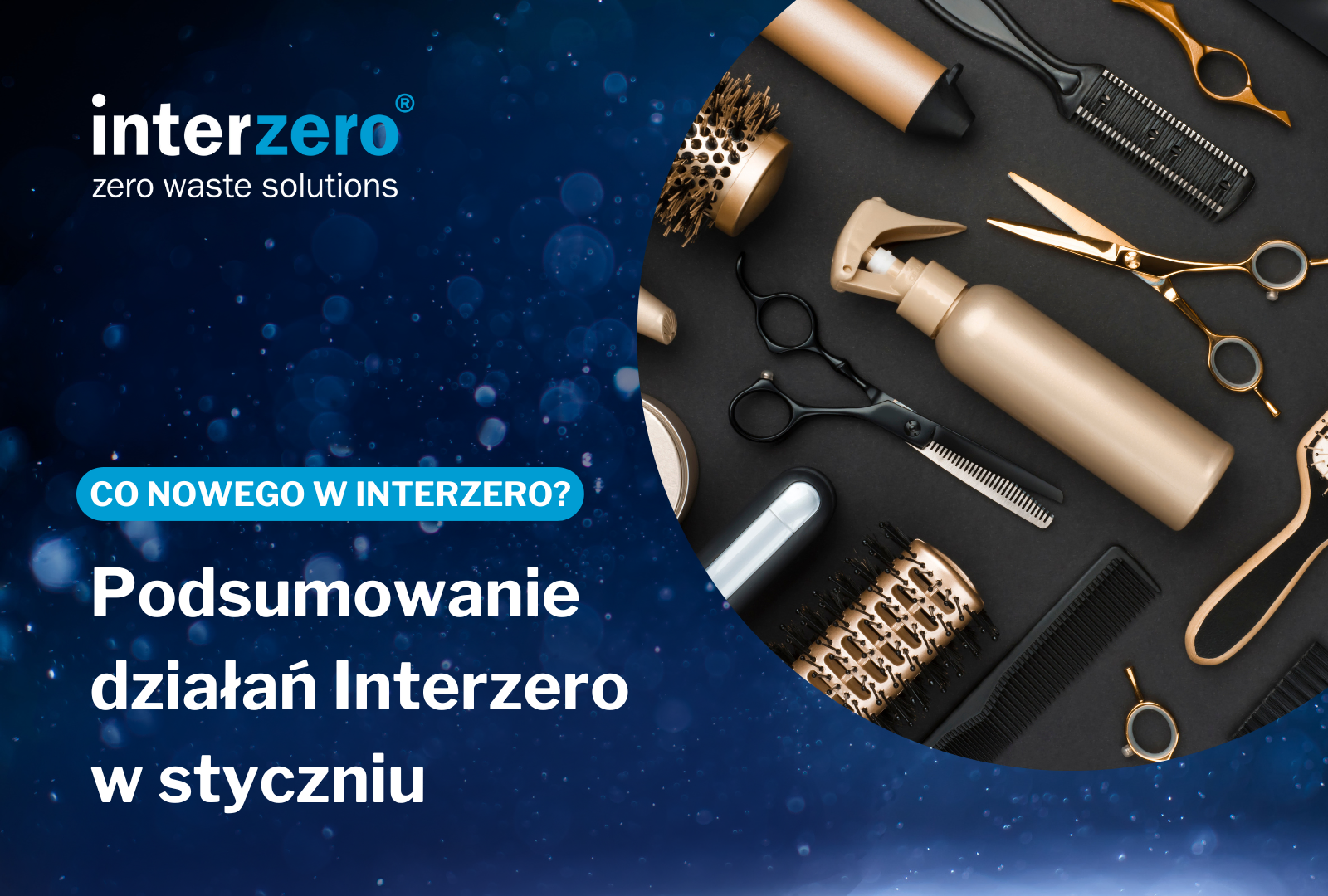
What happened in January? Read Interzero's summary of the last month
We started the new year with enthusiasm and full commitment – we organised trainings, campaigns , educational workshops and launched a new service. We encourage you to read the summary of January in the Interzero Group in Poland, where we present the key events of recent weeks. .
Further entities required to register with BDO
From 2025, the beauty industry is required to comply with new regulations on hazardous waste records. This major change, the obligation to register with BDO, will affect thousands of hairdressers, beauticians and other beauty industry service providers. We have launched a new form, which allows you to contact our company and take over the obligation to register with BDO.
New entry on the website translators to whom the new regulations apply, what penalties are available in the event of non-compliance and what waste is subject to registration with BDO.
New Interzero study: Businesses in the circular economy: a detailed analysis
Did you know that more than 70% of companies want to implement sustainable initiatives? Closing the loop in the economy on a large scale is becoming a fact, as evidenced by the findings presented in the new Interzero study 'Businesses in the Circular Economy: A Detailed Analysis'. Thanks to data collected from senior management in six European countries (Italy, Austria, Poland, Slovenia, Croatia, Serbia). we can show that the adaptation of sustainable models in enterprises is a priority and brings numerous business benefits, including: cost reduction or increased innovation, as well as improved reputation. Our report presents the results of a study on sustainable development trends, market expectations and related business decisions of medium and large enterprises in Europe.
"Waiting for the bail system" - the second part of the report "In the traps of disposability"
In January, the second part of Interzero's report 'In the traps of disposability' was published, entitled "Waiting for bail". This analysis of Poles' knowledge of the bail system shows, among other things, that:
- 23% of respondents had never heard of a bail system
- 41% are concerned that the turnaround points will be too far from their location
- 40% says you may need a receipt to get your deposit back
Even this cursory extraction from the data makes it possible to identify areas that need to be addressed with an appropriate information campaign to bring the way the bail system works closer to home.
The aim of the publication series 'In the Traps of Disposability', produced by Interzero on the basis of quantitative and qualitative research conducted by Opinia24, is to assess the impact of the Single Use Plastics (SUP) Directive coming into force. Speaking more extensively about this, she said on air Polish Radio Four Edyta Mantorska, Manager of the Interzero Environmental Education Team.
January webinar on changes to the bail system is over!
A webinar on the deposit system held on 16 January 2025, hosted by Pawel Sosnowski, Board Representative for Environmental Regulation at Interzero, provided participants with key information on the amendment of the Packaging and Packaging Waste Management Act.
The training discussed the details of the regulatory changes, including the postponement of the launch date for bail schemes, changes to covered drinks, new rules for collecting bail and the introduction of VAT on unclaimed bail.
A great value of the event was the rich Q&A session, which allowed participants to dispel numerous doubts and gain practical information on the new regulations. Thanks to the activity and commitment of the participants, the Q&A became a great opportunity to clarify any ambiguities and discuss problems that entrepreneurs may face.
We invite you to a free webinar " Environmental obligations for companies selling to Poland - everything you need to know " in English, which will take place on February 20, 2025. The training will be led by Przemysław Kuna, Managing Director at Interzero.
4 nthese sections podcast "Eco without the corners"
Where do the differences between commonly available data on waste management come from? Why is it better to say plastics instead of plastic? What environmental issues did Poles live by in 2024 and what awaits us in 2025? These issues were discussed in the podcast 'Eko bez kantów'. We encourage you to listen to the latest episodes on YouTube:
- „ Waste and data - where do the discrepancies come from?"" - Dr. Eng. Beata Waszczyłko-Miłkowska, IOŚ-PIB
- „ Waste management - what do the numbers tell us?" - Dr. Eng. Beata Waszczyłko-Miłkowska, IOŚ-PIB
- „2024 in Ecology. What awaits us in 2025? " - editors: Jakub Pawłowski, Aleksander Jakub Paszyński, Jakub Wojajczyk and Szymon Majewski
- „ Plastic - we need it, even though we don't like to admit it " - Dr. Anna Kozera-Szałkowska, PlasticsEurope Polska
Early Bird promotion: tickets for the 2025 Environment Conference cheaper only until the end of February
The next edition of the Interzero Environmental Conference will take place on June 3-4 at the Hotel Warszawianka near Serock! This is a unique event that will allow you to familiarize yourself with the latest legal changes in environmental protection. Promotion Early birds only lasts until the end of February, so don't delay - share this news with others now! It's also a great opportunity to establish new business contacts. More information about the event can be found at here .
Invitation to Webinar: "Environmental obligations for companies selling to Poland - everything you need to know".
Does your company sell products to Poland? And do you know what environmental obligations this entails? Take part in a free webinar in English!
Why should you participate in the webinar?
During the webinar we will discuss:
- Environmental obligations in Polish law - introduction
- Extended Producer Responsibility (EPR) Explained
- Licensing obligation for sellers and manufacturers
- Role of Authorised Representative
- Good practices and support for companies
- Q&A session
The meeting will be led by Przemyslaw Kuna , Managing Director of Interzero.
How do I join a meeting?
To participate in the webinar, simply register HERE.
Registration is open until February 20th at 8:00 a.m.
Sustainable Development Trends - What and How Much Are Businesses Investing in? Research Report
The transition to a circular economy is inevitable - these are the conclusions of the latest Interzero study , Companies in a Circular Economy: A Detailed Analysis . The ecological transformation of companies is not only forced by legal regulations. It is also expected by customers, investors and financial institutions. The best way to choose the right direction of change is to start working with an environmental consulting company.
Sustainable development as a to-do list for most entrepreneurs
The study Enterprises in the Circular Economy: Detailed Analysis shows that the vast majority of enterprises want to implement sustainable initiatives or have already started this process . Such declarations were made by 71.1 to 84.9% of managers representing medium and large companies from 6 European countries. The most active in this area are companies from the FMCG (81%) and electronics (82%) sectors. For this group of enterprises, implementing circular solutions is no longer considered in the context of competitive advantage -. it becomes necessary to maintain the current position on the market . The situation is slightly different for enterprises from the construction, retail and logistics sectors, where the pursuit of implementing the idea of the circular economy is declared by just over 60% of respondents. From their perspective, introducing green changes allows them to get ahead of the competition, create and control industry trends, and gain the trust of new groups of customers and investors . How much budget do medium and large companies allocate for sustainable development? What activities do they most often invest in?
Download the research report and discover the latest trends in sustainable development!
Actions vs. reality: the state of implementation of the 2030 Agenda in the medium and large enterprise sector
Despite implementing further sustainable initiatives, the vast majority of surveyed companies are still far from achieving the goals of the 2030 Agenda - the non-financial reporting goal, considered to be the "easiest" to implement, was achieved by only 20.5% of those annexed, and the "most difficult" goal of carbon neutrality was achieved by only 15.7% of those surveyed. This state of affairs somehow forces companies to seek advisory support. The surveyed companies almost unanimously expressed their willingness to use the services of an environmental consulting company and entrust it with strategic, managerial and operational tasks.
From the management perspective: reducing waste and increasing efficiency by implementing sustainable solutions
Managers of large and medium-sized companies declared that the introduction of sustainable activities can bring their companies benefits in the form of:
- reducing the amount of waste produced (and consequently reducing waste management costs),
- increasing the efficiency of the company's operations,
- meeting the growing expectations of customers, financial institutions and investors,
- adapting to trends prevailing in the industry. However, the authors of the study emphasize that in order to achieve real benefits, it is necessary to implement changes based on specific data and measurements. Otherwise, companies risk misdirecting their investments. Only 35.5% of the surveyed companies declared that they were assessing the environmental efficiency of products, services and the entire organisation. Some of the surveyed companies stated that they did not have any useful data or research that would allow them to create a strategy for sustainable development of their organisation. This data clearly indicates not only the need to conduct research and development work, but also the need for permanent cooperation with an advisory entity such as Interzero, as an experienced partner specialising in sustainable development.
What kind of support are entrepreneurs looking for? Criteria for choosing an environmental consulting firm
Due to the huge impact of sustainable development activities on the perception of the company by all its stakeholders, companies seeking advisory support are guided by many specific criteria.
- One of the most common criteria is the ability to adapt the offered services to the specifics of the business . Many entrepreneurs have experienced difficulties or even the impossibility of implementing ready-made, unmodified solutions into their business models.
- Equally important is the broad offering of a consulting firm. Respondents particularly value the availability of comprehensive, integrated environmental services and the possibility of using consulting in other areas, not necessarily related to sustainable development.
- A key criterion is also the good reputation of the environmental consulting firm .
As environmental consultants, we understand these expectations of entrepreneurs perfectly. At Interzero, we have been developing integrated environmental protection services tailored to the needs of our clients for over 30 years for companies of all sizes and in every industry. We offer comprehensive environmental consulting , training, audits, and we also provide tailor-made solutions in the field of sustainable development, recycling, waste management and waste machines. We support entrepreneurs in fulfilling their legal environmental obligations and implementing a circular economy. Over 9,500 entities have already trusted us - learn about our environmental services and join the group of clients with whom we implement a common vision of a world without waste.
About the Interzero study
Six countries were analysed: Italy, Austria, Poland, Slovenia, Croatia and Serbia. The objectives of the study were to: understand and analyze market trends in the field of sustainability and the circular economy, investigate potential barriers to the implementation of sustainable practices, investigate the main sustainability needs of medium and large enterprises, analyze the readiness of these enterprises to move towards more sustainable business models. The data analysed in the course of the study came from press releases of enterprises, articles in newspapers and magazines, and reports on sustainability, as well as interviews conducted with top management representing the surveyed enterprises.
What do Poles know about the deposit and do we live in a clean environment? First such data
First steps towards cleanliness
From October 2025, a deposit system for selected beverage packaging will start operating in Poland. This is a response to the challenges related to littering public spaces and meeting EU requirements related to the level of collection of this waste. The new mechanism, included in the Packaging Management Act, is to cover plastic bottles up to 3 litres, aluminium cans up to 1 liter and reusable glass bottles up to 1.5 litres. The system, which aims to simplify segregation and reduce the amount of waste, will be based on a deposit - a fee that we will receive back after returning, for example, an aluminium can at an appropriate point.
Are Poles ready for change?
As shown in the second part of the report "In the traps of disposables - waiting for a deposit". , developed by Interzero, based on qualitative and quantitative research conducted by Opinia24, awareness of the system is at a different level. Every fourth Pole does not know at all that more returnable packaging will appear in our country any moment now, which will have to be returned to stores to get some of the money back. On the other hand, 77% of respondents know about its upcoming introduction, but only 32% correctly indicate that returning bottles does not require crushing, tearing off labels or caps. Such a lack of awareness may contribute to the spread of ignorance and misinformation about the new system and, as a result, affect the undermining of trust in the new mechanism.
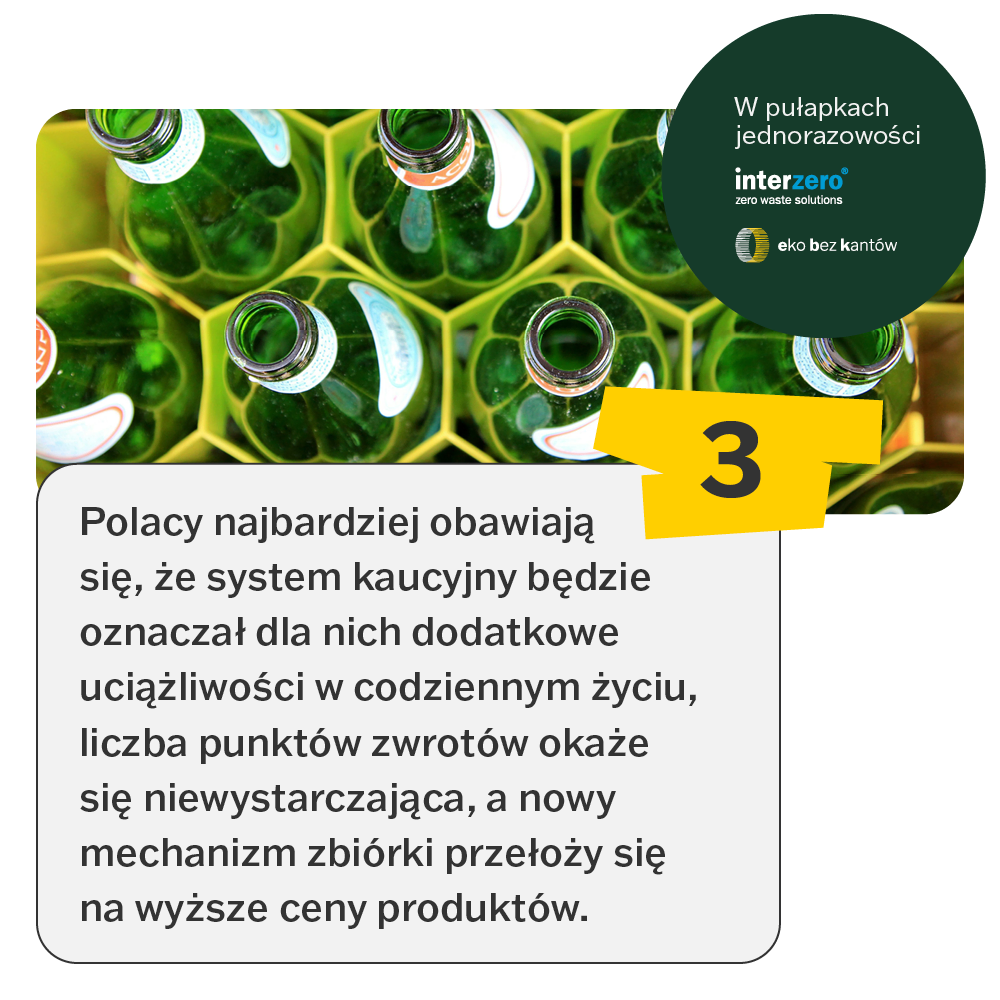
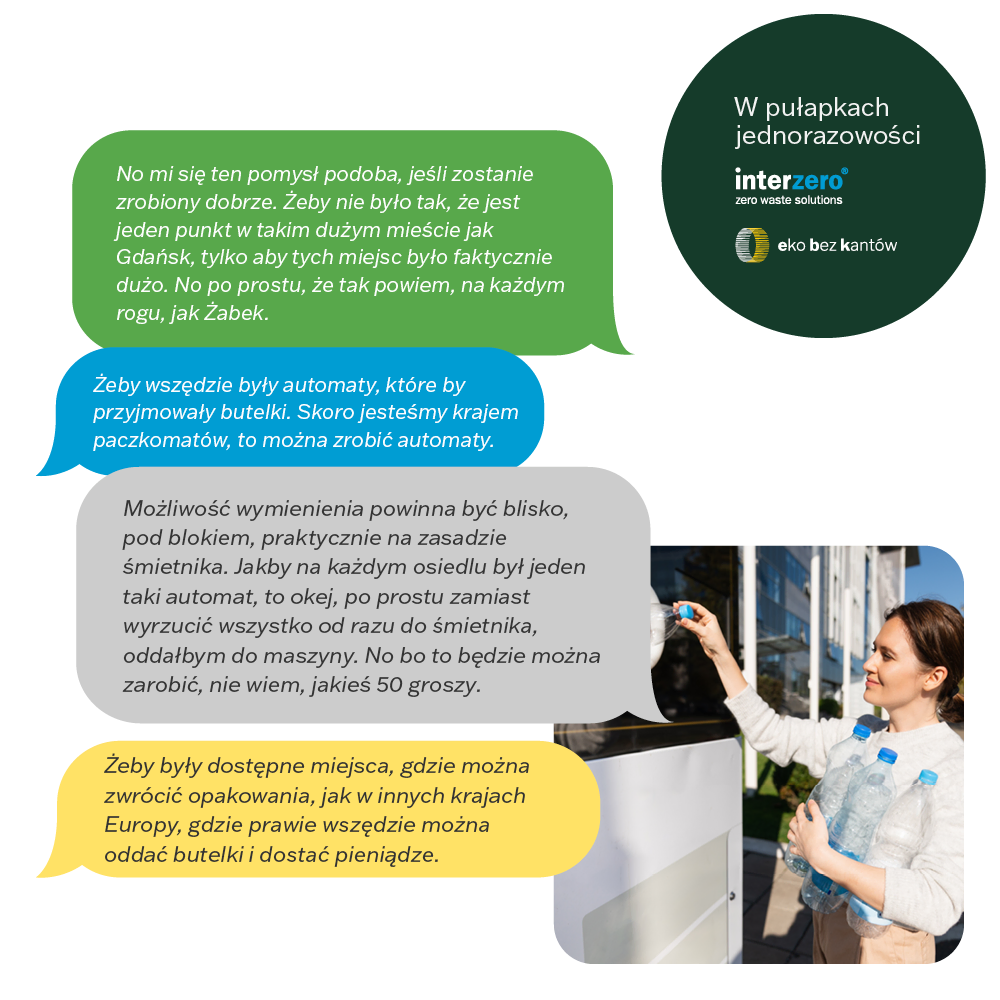
Fears and hopes
According to research, Poles expect the system to be simple and convenient, but at the same time they are afraid of its inconvenience. Nearly 42% of respondents are worried that the packaging will not be able to be returned to every store, and 41% are afraid of the long distances to the return points. Many unjustified doubts are also raised by the need to have a receipt (40%), which will not have to be kept to return cans and bottles. A key element will therefore be appropriate education that clearly explains the principles of the system and the availability of infrastructure on which the convenience of using the deposit system depends.
Deposit system in Europe
In many European Union countries , deposit systems have been operating successfully for years . For example, in Germany, the packaging return rate exceeds 98%, which shows how effective this form of selective collection and recycling of packaging can be. Key success factors include clear rules, the availability of return points (including machines) and an appropriately high deposit rate.
Why is it important?
The deposit system is not only a way to a cleaner environment, but also a possibility of better use of secondary raw materials. In times when the Single Use Plastic directive forces changes in the packaging economy, such solutions are necessary.
Read the full report
The second part of the report "In the traps of disposableness - waiting for a deposit". contains detailed analyses, data and recommendations. If you are interested in how the deposit system will affect our daily lives, or you want to check how you compare to the answers, be sure to read the whole thing on our website. Prepare for change and become part of the solution, not the problem!


